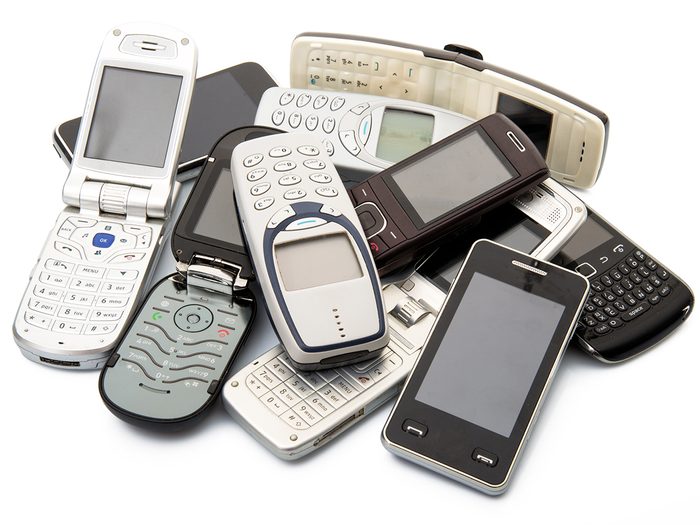If Your Phone Operates on This Network, It’s Time to Get a Replacement

First-generation smartphones will soon be unable to make calls, send texts, or even dial 911.
After U.S. cellphone carriers discontinued 3G service in 2022, Canada’s major carriers—Rogers, Bell, and Telus—are expected to follow in the next few years, disconnecting the cellular network that made first-generation smartphones possible. Although the shutdown process—known as “sunsetting”—will be gradual, eventually all 3G phones (and some other devices) will be useless. Here’s how to get prepared.
What is 3G?
3G, which stands for the third generation of mobile networks, first came online 20 years ago. (The first generation, 1G, came to be in the 1970s with the introduction of portable brick phones.) Representing a major advancement over previous networks, 3G allowed phone users to send and receive data over the Internet, ushering in the smartphone revolution. Now, 3G is being retired to make room on the cellular radio spectrum for 5G, the latest, blazing-fast technology capable of handling data at up to ten times the current rate. 5G service is already supported in major Canadian cities, with the rest of the country to follow in the next few years. Right now, we’re in a transition period where 3G, 4G and 5G are being supported (depending where you live)—but not for long.
Which phones will be affected by the 3G network shutdown in Canada?
Although 93 percent of Canadians have a mobile phone, the 3G network shutdown won’t be an issue for most. The vast majority of us are already using newer smartphones that have been designed for faster 4G mobile networks (also known as LTE or Long Term Evolution), which have covered areas serving 98 percent of the population since 2015. The easiest way to tell which network your phone can support is to turn off Wi-Fi in an area with cellular coverage; the mobile network that kicks in—3G, 4G (LTE) or 5G—will display in the status bar at the top of your screen.

What other devices could be affected?
The 3G sunset could have some unexpected consequences for vulnerable seniors, some car owners, and rural Canadians. There could also be some worrying snafus for businesses and homeowners with devices that rely on what’s called the Internet of Things (IoT), a system of communication between machines that exchange data via cellular networks.
Our daily lives rely on a slew of cellular-connected devices that aren’t phones—traffic lights, medical devices, smart meters, and car GPS systems, to name just a few. Many of these still run on less-sophisticated 3G networks as a cost-saving measure, since they only send and receive small packets of data and don’t need much bandwidth. “We still don’t have a full picture of how the 3G shutdown will affect the Internet of Things,” says technology expert Marc Saltzman. “By the time it happens, we hope all of these systems will be upgraded, and many manufacturers have already done this proactively.”
If they don’t, the onus could be on consumers to make sure their technology is up-to-date, otherwise many Canadians, especially seniors, may lose connectivity just when they need it most. For example, personal mobile alarms, designed to be worn on a wristband or lanyard, have a help button that will automatically dial loved ones in the event of a fall or medical emergency. Most newer models run on 4G networks, but some older types rely on 3G. Be sure to check in with elderly family members to make sure their devices will still work, either by consulting the owner’s manual or contacting the manufacturer.
Home security systems may also use a 3G backup communicator to contact a monitoring centre in the event of a break-in during a power failure or an intruder tampering with wires. And some models of cars, manufactured as recently as 2019, come equipped with 3G-reliant SOS buttons that automatically dial emergency services in the event of a crash. Stay safe by contacting your vehicle and alarm system manufacturers to find out if you need an upgrade.
“Unfortunately, it may take more than simply downloading new software to work on 4G—it’s most likely you’ll need a hardware upgrade,” says Saltzman.
What are the implications for travel?
For Canadians living in remote areas, there’s reason for concern that the 5G revolution may leave them behind altogether. Many places can only access 3G networks—if any at all—and if those are dismantled, will they be replaced? “We’re the second biggest country in the world by land mass, but with a small population of only 40 million,” says Saltzman. “It has to make financial sense for telecommunications companies to invest in new cellular towers, so the federal government will need to step in.” So far, the Canadian Radio and Telecommunications Commission (CRTC) has announced $675 million in funding to upgrade internet and cellular service in underserved areas.
In the United States, the 5G rollout is already well underway, covering thousands of cities. In late December 2022, Verizon completed its 3G network shutdown, the last of the major American carriers to do so. As a Canadian mobile phone user, you may have already received an alert from your service provider warning you that 3G phones will no longer be able to make calls (including 911), send texts, or use Internet-enabled apps south of the border.
Now that you’re prepared for the 3G network shutdown in Canada, check out 10 iPhone hacks you’ll want to try right away.






